Bill Loguidice's Blog, page 125
January 5, 2015
Sord M5, XRGB-mini Framemeister, and Commodore 1084S-P
This is the second in a series of posts on using the XRGB-mini Framemeister with a wide variety of computers and consoles from my collection. This time up, it’s the obscure Sord M5 computer. As before, I’ll be using the versatile classic Commodore 1084S-P (CRT) as the “control” or gold standard for comparison purposes against the XRGB-mini Framemeister hooked up to a modern Sony PlayStation 3D display.
This was actually the first time I took the Sord M5 out of the box. As you can see from the photos, it’s quite diminutive. While this was primarily a Japanese computer and was never released in the US, I have the European version with English instructions, which I got off of an Italian gentleman. You can look at the photos for this blog post here:













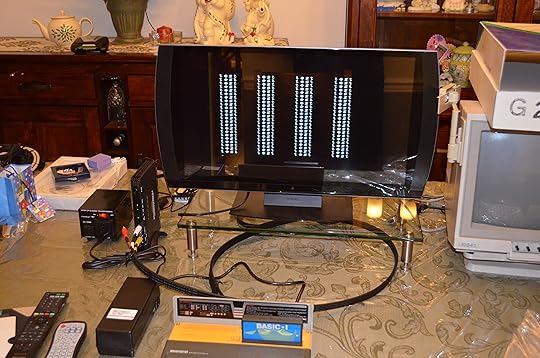



1){tpopt.bw=1;tpopt.bh=1}if(tpopt.bw>1){tpopt.bw=1;tpopt.bh=1}tpopt.height=Math.round(tpopt.startheight*(tpopt.width/tpopt.startwidth));if(tpo... cow=tpopt.container.parent().width();var coh=jQuery(window).height();if(tpopt.fullScreenOffsetContainer!=undefined){try{var offcontainers=tpopt.fullScreenOffsetContainer.split(",");jQuery.each(offcontainers,function(e,t){coh=coh-jQuery(t).outerHeight(true);if(coh
As a first-time user, one thing I noted right away about the machine was that despite being a vintage-style chiclet keyboard, meaning “it’s almost certainly awful,” it’s actually fairly responsive as such things go. What does qualify as “awful” though was the decision to put the spacebar (or space button in this case) where you usually find a Return or Enter key. The other quirk of the machine is that there’s no built-in BASIC interpreter. You need some type of cartridge plugged into the machine to make it do something. It comes with BASIC-I, which is a simplified integer BASIC (also in the box was a baseball and shooting game on cassette, which I didn’t bother to load up). I also purchased from a UK seller a separate BASIC-G (which had no cartridge shell from the factory), which is a game-centric BASIC.
In any case, the voltage is 220v, so I used my usual step-up/down power converter to take care of that. As for audio/video output, the Sord M5 has both RF out and discrete composite video and mono audio outputs. Naturally, I used the composite outputs and ran those straight to the back of the 1084S and then to the front of the Framemeister.
While the 1084S displayed a sharp picture (again, as you can see in the photos), it did so in black and white. I had a similar problem with my Australian Dick Smith Wizzard (a rebadged CreatiVision) on various displays, which was only solved by using my 13″ Sharp world TV (CRT). I didn’t bother to try that here, though.
The Framemeister looked pretty good using the same settings I used on the Adam (NATURAL picture, STANDARD aspect ratio, 1080p/60 output), save for one thing. Here’s some video (again, captured at only 720p from the 1080p/60 output) of me entering in (poorly) a simple BASIC-G program:
As you’ll note from the video, there were odd colored lines on the extreme left of the picture that weren’t present on the 1084S. Clearly, it’s some type of overscan/underscan-type thing. It’s by no means a deal breaker, as it showed color where the 10804S didn’t, but it is frustrating I couldn’t get that out of the output. In any case, although the Sharp world TV may prove the best option, using the Framemeister for this system is a viable option.
January 3, 2015
Video of the Coleco Adam output on XRGB-mini Framemeister
As indicated in my previous blog post, found here, I’ll be testing various systems on the XRGB-mini Framemeister. In the first such test, I tried the Coleco Adam, but failed to do any direct video capture to show the results. I’ve rectified that in the simplest way possible using the AVerMedia Live Gamer Portable, which lets you record directly to an SD card without a PC (doing the latter obviously provides greater control over the results, but is more time consuming for my purposes) and has a convenient HDMI pass-through so I can see the original output on my display without any lag. As you’ll note from the blog post, I’m outputting from the Framemeister at a full 1920x1080p at 60 frames per second (Note that I used the Adam’s MONITOR output for video and AUX VIDEO for the split mono audio to go to the Framemeister). The AVerMedia Live Gamer Portable, as you may or may note from the YouTube details, only allows for 1280x720p at 59 frames per second in its non-PC mode, so it’s not necessarily indicative of the actual quality (and YouTube maxes it out at 720/60). With that in mind, to me, it looks like it does on my Sony PlayStation 3D display, so I’m satisfied with that for this test and all future tests, which will have the video directly embedded in the detailed blog post, rather than separate like it was in this instance. Enjoy.
January 2, 2015
Coleco Adam, XRGB-mini Framemeister, and Commodore 1084S-P
This is going to be the first in a series of posts on using the XRGB-mini Framemeister with a wide variety of computers and consoles from my collection. I’ll discuss optimal settings and configurations, as well as any potential pitfalls. Wherever possible, I’ll be using the legendarily versatile classic Commodore 1084S-P (CRT) as the “control” or gold standard for comparison purposes against the XRGB-mini Framemeister hooked up to a Sony PlayStation 3D display (LCD/LED; note that I did try other LCD displays and was not satisfied with the quality–the XRGB is only as good as the modern display it’s going to!). First up is the Coleco Adam.
There are actually two ways to get composite output from the Coleco Adam. One is the Adam’s MONITOR port, which does composite video using a single composite cable, and the other is the Adam’s AUX VIDEO port (DIN), which is using a fairly standard monitor cable to output composite video and mono audio. The nice thing about these options is that both can be used at the same time, which is how I was able to get the side-by-side photos. In the future, I’ll be doing direct video captures, but for these initial tests I’ll just be doing quick iPhone photos. While this is not an ideal way of showing output on a CRT thanks to the way that technology displays images (accounting for darkness and/or lines in photos that are not present when viewing it live), it should still give a general sense of the comparative quality.

Coleco Adam SmartWriter. XRGB-mini Framemeister on a Sony PlayStation 3D display on the left, and a Commodore 1084S-P on the right.
The monitor cable I’m using with the Adam is a fairly low quality five pin model, with composite video and audio. The latter is “stereo” in that the mono audio signal is split/mirrored on both connectors. I plugged that into the front of the XRGB-mini. The output from the XRGB-mini was sent via HDMI to the PlayStation 3D display on its first input.

Coleco Adam BurgerTime. XRGB-mini Framemeister on a Sony PlayStation 3D display on the left, and a Commodore 1084S-P on the right.
In this case, after trying nearly every possible configuration option, I found the most pleasing settings on the XRGB-mini to be NATURAL for the Processing Mode with STANDARD aspect ratio. BRIGHTNESS was set to 19, which allowed the black levels to match that of the PlayStation 3D display. The PlayStation 3D display was set to STANDARD mode with all default settings. Both the XRGB-mini and PlayStation 3D display were set to output and receive 1920x1080p/60 resolution/frame rate, respectively.

Coleco Adam EOS menu. XRGB-mini Framemeister on a Sony PlayStation 3D display on the left, and a Commodore 1084S-P on the right.
A single composite video cable went from the Adam’s MONITOR port to the rear of the 1084S-P. In theory, the XRGB-mini is taking the raw video output and only doing minimal color processing, so I used the PlayStation 3D display to help calibrate the colors on the 1084S-P, which is more susceptible to the vagaries of the classic NTSC standard.

Coleco Adam SmartBASIC. XRGB-mini Framemeister on a Sony PlayStation 3D display on the left, and a Commodore 1084S-P on the right.
As you can tell from the photos, with those settings, the XRGB-mini is a close match to the 1084S-P. While the color saturation (though not necessarily the actual colors) and black levels were naturally better on the 1084S-P, unless you’re doing a direct comparison, the XRGB-mini paired with the PlayStation 3D display proves a worthy modern day alternative.
December 24, 2014
Holiday memories from The History of Personal Computing podcast
The History of Personal Computing podcast, hosted by Jeff Salzman and David Greelish, has a special holiday episode, entitled: Special Episode: Holiday Memories. In the podcast, holiday memories for various computer- and videogame-related gifts are recounted, with segments from several different contributors. I contribute the second segment, where I talk about receiving my first printer, a Commodore MPS-803 (and yes, I eventually got the tractor feed for it), for my Commodore 64, which was my second computer after the Commodore Vic-20. Give it a listen, and be sure to let us know your own memories in the comments. Happy holidays!
December 22, 2014
Videogame Documentary “Gameplay” Premieres Exclusively on Vutopia in January!
Our feature film documentary, Gameplay: The Story of the Videogame Revolution, in partnership with Gravitas Ventures, will have an exclusive 30 day premiere on Vutopia. The premiere will begin on January 6, 2015, and run through February 6, 2015.
Vutopia is the movie lover’s ultimate destination. It’s all of your favorite movies On Demand, available to watch on TV and online, anytime you want. Vutopia offers many movies including Hollywood favorites, indie movies and documentaries, with new movies premiering each month. It’s a movie for every mood in cool categories that make the search as fun as the find. Vutopia is your movie happy place.
Vutopia is currently available as a part of Movie Pass from Time Warner Cable and Bright House Networks.
Gameplay: The Story of the Videogame Revolution is a feature documentary film on the history of videogames. Almost five years in the making, the film spans the industry’s origins and beyond as it chronicles the remarkable story of the fastest evolving new media of all time.
The film features never seen before interviews with such videogame pioneers as Nolan Bushnell, David Crane, Noah Falstein, John Romero, Todd Howard, and many more, plus all of the iconic and groundbreaking games of the past 50 years or so, all tied together with original animation and graphics.
A press release and information on additional showings will follow.
Gameplay: The Story of the Videogame Revolution from Tom Coleman on Vimeo.
December 18, 2014
Nova Phase, a new digital comic inspired by 16-bit videogames
Described simply as a “treasure hunt in space with old school video game graphics,” Nova Phase is a creator-owned six issue digital comic series created by writer Matthew Ritter and artist Adam Elbatiny. A better description is a pixel art space western, and, having personally reviewed the first four issues, each of which is available from www.comixology.com, I can say that it’s not only worth checking out the first free issue, but also the three subsequent issues that are available. Publisher Slave Labor Graphics has also made a print version of the first two issues available for sale through their Website and Amazon.



As you can see from the sample pages above, the art and overall design is well done (though more 16-bit than 8-bit in my opinion), and I found the writing to be sharp, with intelligent and clever dialog and interactions between the various characters. In fact, I found the overall package to be a less serious take off on the very first computer-produced comic, Shatter, which originally dates to 1985 and was produced on the original Apple Macintosh with MacPaint.
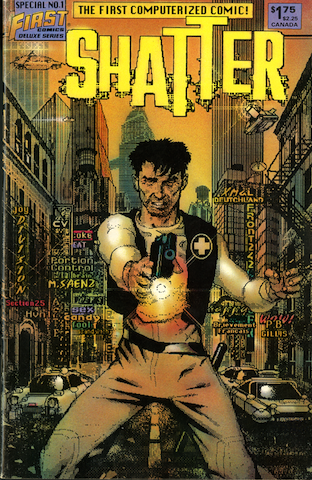
The cover for Shatter special number 1, 1985. Note the passing similarity to…

…the cover for Nova Phase, issue 2.

Some pages from Shatter when it appeared in issue 12, March 1985, of the videogame magazine, Big K. I really like that Nova Phase mimics much of this style.
Finally, there’s some 8-bit music inspired by Nova Phase to enhance the reading experience. This music, crafted by Andrew Huang, can be listened to at www.14hoursproductions.com/bittunes/.

The promotional back cover for Nova Phase, issue 1
December 16, 2014
New power supply for the Coleco Adam
Thanks to enterprising hardware hacker, Rey Lopez, there is now a new replacement for the Coleco Adam’s power supply, which, if you’re unaware, was placed inside its enormous printer. Many modern users of the Coleco Adam, such as myself, have typically pulled the power supply out of the Adam’s printer and put it in a makeshift hobby box. While this worked just fine, the power supply was still quite large, still quite heavy, and not exactly the ideal solution for continuing to power the computer. A typical alternative to this approach has been modifying an arcade or PC power supply, an approach that Lopez takes with his Memory Console Power Supply. It’s light, has a reasonably quiet fan, and looks rather professional, including its custom label. You can inquire about the possibility of getting your own power supply from Lopez’s thread on AtariAge.
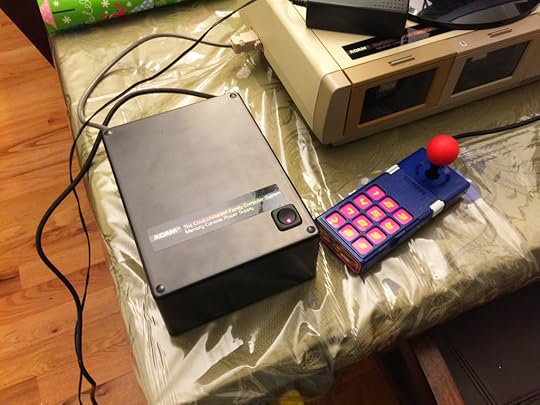
My power supply next to a customized original ColecoVision controller for size comparison. Despite a scratch near the top rear of the power supply, I’m quite happy with how it turned out.
Despite issues with the first revision of this product – which Lopez addressed quickly, including for me – the latest revision has passed all tests on my fully populated Coleco Adam. This will definitely be my new go-to power supply.

The power supply has a smooth on/off switch with a modest indicator light. As for my quick test setup, let’s just say I set up where and with what was most convenient.

While the first revision of this product had a noisy fan, this current revision is considerably improved.
December 11, 2014
Hemingwrite Kickstarter and the promise of distraction-free writing
As a professional writer, the new Hemingwrite Kickstarter certainly caught my eye. Its tagline is “A Distraction Free Digital Typewriter,” which certainly has its appeal. I can speak from both my own personal and extended social experiences with fellow writers that the collective we often like to romanticize the concept of the “writing process.” The Hemingwrite is just the latest of countless attempts to cash in on what for many of us seems to be a primal need for that ideal writing environment, where the hoped-for end result is that the words simply flow out, mocking even the idea that there’s something out there called writer’s block.
The same is of course true of those who don’t actively write, but want to. I know I’ve certainly seen and commented on my fair share of statements from hopeful individuals who want to write on an old computer like the original IBM PC (I too love tactile, clicky keyboards, with this being one of my more recent acquisitions) or even on a typewriter (or a converted typewriter), so they might somehow feel more connected to the written word. Of course, knowing a thing or two about how the modern publishing world operates and having experienced my fair share of typewriters and vintage word processing in my 42 years on this planet, I’m quick to point out that eventually you have to get your output onto a modern system, are introducing quite a few extra steps into an already labor intensive process, and are opening yourself up to multiple points of failure. In short, for all their foibles, modern computers and their related software environments are far more stable and easier to safeguard against disaster despite the fact that past greats like Hemingway, Murrow, or even Asimov never got to use them.

The Tandy 100 from 1983. This was a jouralist’s best friend throughout the 1980s and part of the 1990s. Though less ambitious, the Hemingwrite is definitely a spiritual successor. (Source: Wikipedia via NapoliRoma)
That’s of course not to say that I haven’t personally fallen prey to the allure of the “perfect” writing environment. I have an impressive wake of hardware, software, and tools to prove that indeed I have. In general, experience usually does eventually show you the reality of what it really takes to get something done. With writing, it’s no different. You not only have to constantly write to get better, you also have to experiment to know what works best. Eventually you should reach the point where it doesn’t matter where you are or what you have to write with in spite of, not because of, whatever personal quirks happen to influence you at any given moment.

The Hemingwrite in action, straight from the Kickstarter page.
So, with the above in mind, while the Hemingwrite is not the cure for your potential writing woes, it does appear – if it delivers as promised of course – that it might prove a useful tool under the right circumstances, much like other “minimal” software and hardware. In my case, my portable workhorse is the delightful Surface Pro 3, but I must say, having a rugged, extreme battery life writing-specific device with modern wireless transfer capabilities might be a nice companion for those situations where an ultrabook-type computer is either not convenient or particularly necessary.
I do think that a device like the Hemingwrite is probably not something you want to use for writing that requires any type of connected reference or research since you’d need a secondary device, like a smartphone, for that function, which would take away a lot of the point of ignoring the most distracting elements of modern technology in lieu of this. However, if what you wish to write requires little-to-no-research or can be researched and refined on something else at a later date (fiction might be the best example), it just might be a good way to knock out a quick draft. It’s also something I’d feel comfortable recommending to those hopeless romantics who fantasize about banging away on a typewriter, since your work is easy to get off it and into a modern, usable format on another platform.

Clicky keys and switches? What type of unholy fusion of hipster and steampunk sensibilities is this? (Source: Kickstarter)
That’s not to say I don’t have some concerns about the Hemingwrite. There’s no way to know how good the visibility of the screen will be at arm’s length, since this is more or less the same type of screen found on eReaders designed to all but be smooshed up against your face. I’m also lukewarm on the lack of a front-lit screen or back-lit keyboard keys. The former creates more versatile usage in poorly lit settings, and the latter seems to help my aging eyes stay less strained and fatigued in lower light settings. Of course, I do agree that feature creep can present quite a few issues, so even if the device were to end up simply as presently envisioned, I think I’m still OK with that.
If you can find a use case for the Hemingwrite, I say go for it. If you think the Hemingwrite will help you get your writing going or help you to take it to another level, I’d strongly recommend thinking again. The only thing that will do that is actually writing, and doing as much of it you can as each day, refining your technique as you go. That shouldn’t require any further augmentation beyond the very device you’re reading my blog post with. As that tired corporate slogan states, JUST DO IT.
December 8, 2014
Review of Lamb Chops! and Retro Fever for the Apple II
The Apple II series of computers, which first came to market in June 1977, and didn’t end production until November 1994, were a premiere videogame platform throughout most of the 1980s. What’s interesting is that, as detailed in books like Vintage Games (2008) and Vintage Game Consoles (2014), despite the platform’s pedigree and devoted present day following, comparatively few new homebrew games have been created for it. Fortunately, a few talented individuals have decided to address this unfortunate oversight, including one Brian Picchi.

Lamb Chops! packaging
Picchi cut his teeth on a series of Applesoft BASIC games, including Applesoft Action, Dogfighters of Mars, Surfshooter, The Deadly Orbs, and Double Deadly Orbs. While each of these increasingly impressive titles were fine examples of both Picchi’s skill and Applesoft BASIC’s flexibility, it was clear the author was pushing against the user friendly language’s limitations. While some programmers might have happily chugged along with BASIC, Picchi decided instead to learn Assembly, a low-level programming language that really lets coders tap into the potential of a system’s technology. Despite the high learning curve, the advanced language was ideal for the type of action games Picchi previously made in BASIC, so the author kept the genre bias going for his first two creations that made use of more sophisticated programming techniques, Lamp Chops! and Retro Fever.
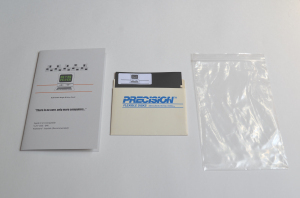
Retro Fever packaging
Lamp Chops!, which Picchi wrote with the aid of the Merlin macroassembler, is an action game described as a cross between the arcade classic, Robotron: 2084 (1982), and the classroom staple, The Oregon Trail (1971), the latter of which inspired its setting. The premise of the game is that you’re a sheep farmer whose flock has escaped. Armed with a shotgun, you must protect your sheep from various forest creatures, which include wolves, yetis, and aliens (!), as your flock tries to cross from one side of the screen to the other, one at a time.
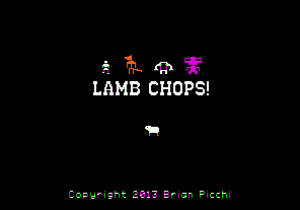
Lamb Chops! title screen
As with many classic shooters, the action is straightforward. If you touch an enemy or lose three sheep in a level, including any you accidentally shoot, you lose a life. Shoot enemies for points and earn an extra life for every 1,000 points. Complicating matters is that each shot must either hit an object or clear the screen before you can fire another. The action gets harder with each level you pass, up to level 20, where your reward for dying becomes a better Game Over screen.
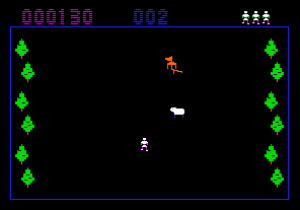
Lamb Chops! play screen
Animation is minimal, with the main character’s legs moving as you run, while the sheep, forest creatures, and bullet merely slide across the screen as a static image. Objects other than the main character exhibit flicker as they move, with the white sheep the worst of the offenders. The sheep speeds up if you kill the pursuing forest creature, and slows down again once the next enemy appears. Sound is similarly sparse, with a beep or buzz indicating some type of contact with another object, and a short tune plays when the game starts and when it’s game over. Control is tight and supported from the keyboard, paddles, or the preferred joystick.
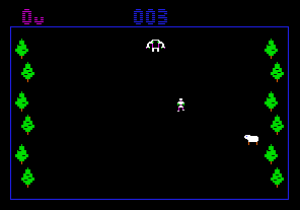
Lamb Chops! play screen
Retro Fever, which Picchi wrote in collaboration with Retroswitch.com’s Brandon Bogle, primarily using the C language, is a multi-stage action game with its respective levels inspired by the core game mechanics found in arcade classics like Food Fight (1983), Lady Bug (1981), and Missile Command (1980). The premise of the game is that you’re an Apple II enthusiast trying to add to and protect your collection. You do this across three unique levels: a recycling center, repair center, and outdoors.
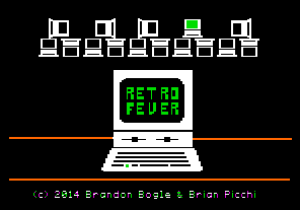
Retro Fever title screen
In the recycling center level, you need to grab the computers from the conveyors on the top and bottom of the screen before they reach the incinerator or are resold on eBay by the evil businessman (reseller) or your angry wife for inflated prices. You can collect a clock to temporarily freeze the reseller and your wife, or collect and drop cash to distract them. Touching either the reseller or your wife results in the loss of one of your five lives.
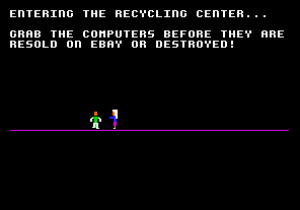
Retro Fever recycling center intro
In the repair center, you need to avoid the lab rat while repairing your computers with the right parts. You check what part letter each of the three computers on the left side of the screen needs, then you search for the matching part in the 12 parts bins. Once you find the right part, bring it back to the computer to fix it. Impeding your progress are one or more fast moving rats that are deadly to the touch. Collecting a lantern (which looks an awful lot like a bagel) will temporarily show the letters in all of the parts bins. Similarly, collecting a question mark (special part) and bringing it to a computer will automatically repair it, saving even more time on your search for the three matching parts.
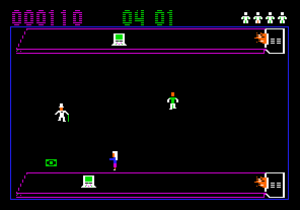
Retro Fever recycling center play screen
Finally, in the outdoors level, you must protect your computers from the sun’s yellowing effects, in the form of falling beams of light, using only an umbrella. If you touch a beam with anything on your body other than the umbrella, you lose a life. To complicate matters, your wife is back, as is the reseller, who’s now driving a car careening down the roadway. As before, making contact with either your wife or the reseller results in the loss of a life. Finally, you’ll get 1,000 bonus points if you acquire, but don’t use, the flask of RetroBrite for the duration of the round. Once all three levels are beaten, the game starts over, with the difficultly ramped up further.
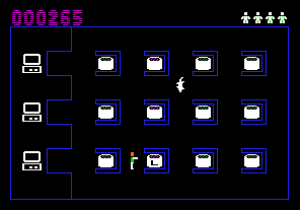
Retro Fever repair center play screen
The action is smoother than Lamp Chops!, with minimal flicker and considerably more animation. Sound is similarly improved, with more elaborate intro and outro music and more frequent use of the simple sound effects. As expected, control is tight and also supported from the keyboard, paddles, or the preferred joystick.
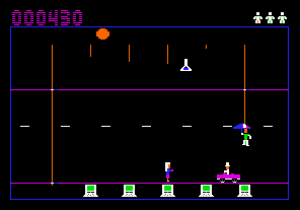
Retro Fever recycling center play screen
The retail versions of each of the games were reviewed on a stock Apple //c with Commodore 1984S monitor and Kraft analog joystick. Both Lamb Chops! and Retro Fever, each complete with manual, disk, and plastic zip bag (a packaging staple for early commercial computer games), are available for purchase from the author’s Website by going to http://tanrunomad.com/official-games/ and run on any Apple II or compatible with 64K. You can also play all of Picci’s homebrew games for free right in your Web browser, by going to: http://tanrunomad.com/vintage-computer-collection/my-homebrew-games/. Disk images for use in offline emulators or on the real hardware are also free and available from his Website.
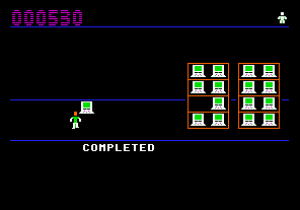
Retro Fever end of first round
While neither game innovates for the platform, both are fun action games that help breathe new life into the Apple II’s lethargic homebrew gaming community. While some may appreciate the simplicity of Lamb Chops!, which successfully channels the spirit of games you’d find on the platform in the late 1970s to very early 1980s, there’s no denying that the multi-level Retro Fever, which is more like the type of game you’d find on the platform just a few years later, is the more complete creation and the game to get if you only pick one.
Want to support Armchair Arcade?

December 7, 2014
A quick look back on the Sony PlayStation’s 20th Anniversary
Inspired by my colleague’s video of his thoughts on the Sony PlayStation‘s 20th anniversary, I thought I would share my own remembrances. The original PlayStation console was released on December 3, 1994, in Japan, and in the US on September 9, 1995. While it was on the latter date that I got a PlayStation of my own, it’s obviously the earlier date that we’re celebrating the anniversary for this month. In fact, Sony and other companies have been getting in on the festivities, with cool original PlayStation-themed PlayStation 4‘s (currently leading the next generation pack), and free games.
While you can read about the history of the PlayStation and my full thoughts on the now legendary system in Chapter 3.2 of Vintage Game Consoles (and of course 19 of the other greatest consoles, handheld, and computer game playing platforms of all time), I’ll summarize here. After selling off a good-sized portion of my Sega Genesis and Super Nintendo collections for credit, I went to my local Electronics Boutique (which I worked at for a time in college) and stood in line on the launch day to get my unit. Up until the US launch of the Sega Dreamcast about four years later, console launches weren’t really a big deal, although there was a respectable line, which was still a bit unusual, particularly since this was Sony’s first foray into consoles after an at-best mediocre attempt developing third party console games. In any case, that line was definitely a sign of things to come.
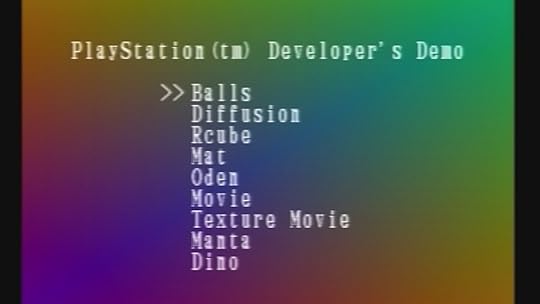
The menu screen from my PlayStation Developer’s Demo disc.
At the time, I only literally had enough money for the unit itself and no additional games, but luckily the launch units came with two discs. While Sony bucked convention by omitting a pack-in game – which has sadly become the norm – the primary sample disc, dubbed PlayStation Picks, was actually packed full of game demos, which included titles like the striking, if shallow, 3D fighter, Battle Arena Toshinden. It was of course Sony’s gamble on creating a 3D-centric (actually, polygon-centric) console that made the PlayStation seem so fresh and exciting–a literal technological dividing line between the old and new way of doing things had been crossed. In fact, unlike its competitors, Sony was all in on this relatively new mainstream technology, with few compromises, and backed it up with a reasonably speedy CD-ROM drive, something even the PlayStation’s later 3D-centric rival, the Nintendo 64, would omit to its own detriment.

“Movie” from my PlayStation Developer’s Demo disc, showcasing the high quality video that could be generated when all system resources were used.

“Movie” from my PlayStation Developer’s Demo disc, showcasing the high quality video that could be generated when all system resources were used.

“Movie” from my PlayStation Developer’s Demo disc, showcasing how video could be manipulated and warped onto polygons.
The other disc was the PlayStation Developer’s Demo, which only a few retailers carried. Luckily, mine did. On it were bite-sized technical demos showing high polygon count interactive 3D models and high resolution video clips. Again, the PlayStation was a technical marvel for the time, and Sony made sure you knew it. Of course, a console is nothing without games, and Sony made sure that the US launch featured a huge launch library, making the earlier, clumsy Sega Saturn launch with just a few buggy titles seem like amateur hour (the Saturn never did recover momentum). Sony truly executed like an old master and both first and third party game support never stopped, with well over 2,400 titles in its library across all regions by the time of the last official game release in Japan in 2006, about a dozen years later.
In any case, I played the heck out of both demo discs and slowly built up my PlayStation library over time. While I did end up selling some titles to fund new acquisitions, I got most of the classics back over the years. Just like the Nintendo Entertainment System created life-long Nintendo fans, Sony’s first console created life-long PlayStation fans. While as a collector, I’m a fan of just about everything, I definitely have a soft spot for the PlayStation and how it ushered in the first major technological transition since the release of the first programmable videogame consoles and cartridges back in 1976. For that alone, it will always have an important place in videogame history.




